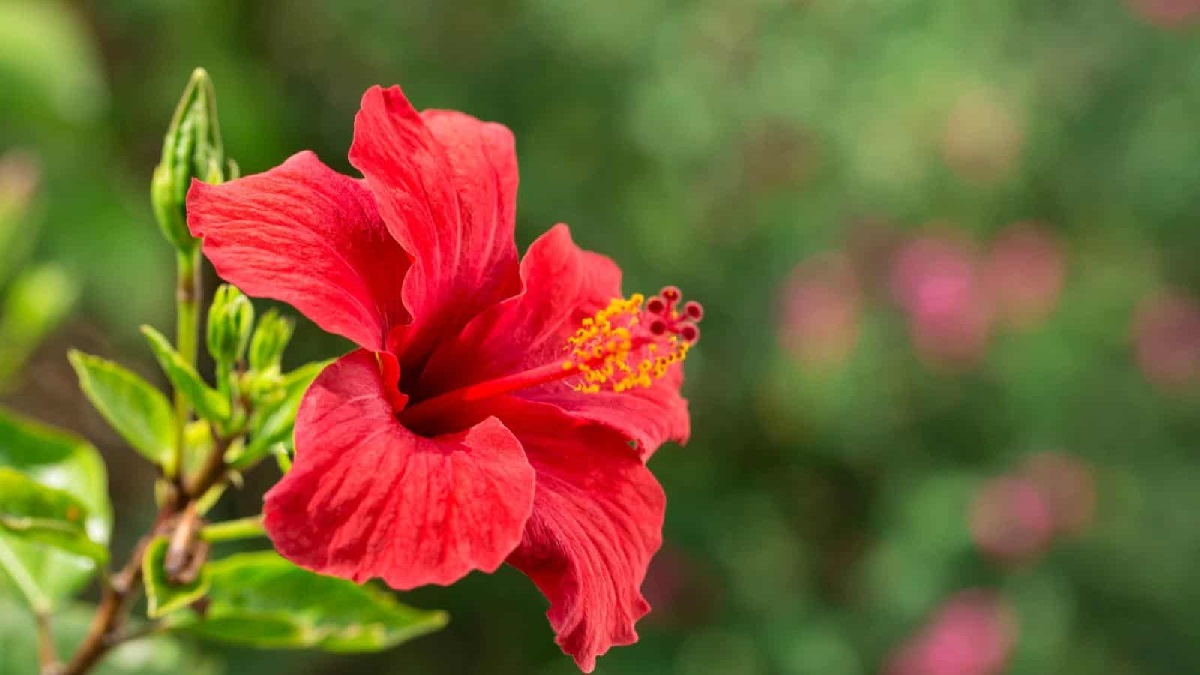Home>Weather and Climate>The Ultimate Guide To Growing And Caring For Hibiscus Flowers


Weather and Climate
The Ultimate Guide To Growing And Caring For Hibiscus Flowers
Published: March 2, 2024
Learn how weather and climate impact the growth and care of hibiscus flowers with our ultimate guide. Discover expert tips for optimal conditions.
(Many of the links in this article redirect to a specific reviewed product. Your purchase of these products through affiliate links helps to generate commission for Temperatures.com, at no extra cost. Learn more)
Table of Contents
Introduction
Hibiscus flowers are renowned for their stunning beauty and vibrant colors, making them a beloved addition to gardens and landscapes around the world. These exquisite blooms, with their delicate petals and striking hues, have captivated the hearts of gardening enthusiasts and nature lovers alike. In this comprehensive guide, we will delve into the art of growing and caring for hibiscus flowers, exploring the essential steps to nurture these botanical treasures and witness their splendor unfold.
From the tropical regions of Asia to the sunny landscapes of the Mediterranean, hibiscus flowers have enchanted people for centuries with their alluring charm and diverse varieties. Whether adorning a lush garden or brightening up a balcony, these blossoms bring a touch of elegance and allure to any outdoor space. As we embark on this hibiscus journey, we will uncover the secrets to cultivating these enchanting flowers, from selecting the ideal location to mastering the art of nurturing them through each stage of growth.
As we venture into the world of hibiscus flowers, we will unravel the intricacies of their unique characteristics and the factors that contribute to their flourishing beauty. Through this guide, you will gain valuable insights into the art of tending to hibiscus flowers, allowing you to cultivate a deeper appreciation for these botanical marvels. Whether you are a seasoned gardener or a novice enthusiast, this guide will equip you with the knowledge and expertise needed to cultivate and nurture hibiscus flowers with confidence and success.
Join us on this hibiscus odyssey as we unlock the secrets to growing and caring for these captivating blooms, and embark on a journey that celebrates the timeless allure and natural splendor of hibiscus flowers.
Read more: Essential Plumeria Care Guide
Understanding Hibiscus Flowers
Hibiscus flowers, belonging to the Malvaceae family, encompass a diverse array of species, each possessing its own unique charm and characteristics. These exquisite blooms are renowned for their large, showy petals that form a striking focal point in any garden or landscape. With their vibrant colors ranging from fiery reds and oranges to soft pinks and whites, hibiscus flowers exude an irresistible allure that captivates the senses.
One of the most distinctive features of hibiscus flowers is their prominent stamens, which extend gracefully from the center of the bloom, adding an elegant touch to their overall appearance. These stamens, adorned with pollen-laden anthers, play a crucial role in the pollination process, attracting bees, butterflies, and hummingbirds, thus contributing to the ecological tapestry of the garden.
Hibiscus flowers are known for their ephemeral beauty, with each bloom typically lasting for only a day before gracefully fading away. However, the prolific nature of hibiscus plants ensures a continuous cycle of blossoming, offering a spectacle of color and vitality throughout the growing season.
The leaves of hibiscus plants are often glossy and deeply lobed, providing an attractive backdrop to the resplendent blooms. The foliage varies in shades of green, with some species featuring burgundy-tinged leaves that add a dramatic contrast to the overall aesthetic of the plant.
These captivating flowers thrive in warm, tropical climates, where they bask in the abundant sunshine and flourish in well-drained, fertile soil. While hibiscus plants are predominantly associated with tropical regions, certain species have adapted to thrive in temperate climates, adding a touch of exotic allure to gardens in diverse geographical locations.
The enchanting allure of hibiscus flowers extends beyond their visual appeal, as they have also been revered for their medicinal properties and culinary uses in various cultures. From soothing herbal teas to ornamental garnishes, hibiscus flowers have woven themselves into the fabric of human traditions, embodying a rich tapestry of cultural significance and botanical wonder.
In essence, understanding hibiscus flowers entails embracing their ephemeral beauty, appreciating their ecological role, and recognizing their cultural and horticultural significance. As we delve deeper into the world of hibiscus flowers, we unravel the intricate tapestry of their allure and gain a profound appreciation for these botanical treasures.
Choosing the Right Location
Selecting the ideal location for cultivating hibiscus flowers is paramount to their overall health and vitality. These vibrant blooms thrive in warm, sunny environments, making it essential to choose a spot that provides ample sunlight and protection from harsh winds. When seeking the perfect location for hibiscus, consider the following factors to ensure optimal growth and blooming:
-
Sunlight Exposure: Hibiscus flowers flourish in full sunlight, requiring at least six to eight hours of direct sunlight daily. Choose a location in your garden or outdoor space that receives abundant sunlight, preferably in the morning to allow the plants to bask in the gentle warmth of the sun.
-
Protection from Wind: While hibiscus plants adore sunlight, they are sensitive to strong winds, which can damage their delicate blooms and foliage. Select a sheltered spot that provides a natural barrier against strong gusts, such as near a fence, hedge, or building, to shield the plants from potential wind damage.
-
Well-Drained Soil: Hibiscus flowers thrive in well-drained, fertile soil that retains moisture without becoming waterlogged. Avoid low-lying areas that are prone to water accumulation, as excessive moisture can lead to root rot and other detrimental conditions. Instead, opt for elevated ground or well-drained soil to promote healthy root development.
-
Climate Considerations: Consider the climate of your region when choosing the location for hibiscus flowers. While these blooms are synonymous with tropical environments, certain species can adapt to thrive in temperate climates. Research the specific hibiscus variety you intend to cultivate and ensure that your location aligns with its climatic requirements.
-
Space and Aesthetic Appeal: Evaluate the available space and aesthetic considerations when selecting the location for hibiscus flowers. These vibrant blooms make stunning focal points in gardens, borders, and containers, so choose a spot that complements the overall design of your outdoor space while allowing the plants to flourish and showcase their resplendent beauty.
By carefully considering these factors and selecting a location that meets the specific needs of hibiscus flowers, you can create an optimal environment for their growth and blooming. The right location sets the stage for a flourishing hibiscus garden, allowing these captivating blooms to thrive and enchant with their radiant colors and delicate allure.
Planting Hibiscus Flowers
Planting hibiscus flowers marks the beginning of a captivating journey, as you carefully establish the foundation for their growth and blooming. Whether you are cultivating these vibrant blooms in a garden bed or adorning your outdoor space with potted hibiscus plants, the process of planting sets the stage for their flourishing beauty.
Selecting the Right Time
Choosing the optimal time for planting hibiscus flowers is crucial to their successful establishment. In temperate climates, it is advisable to plant hibiscus in the spring, once the threat of frost has passed and the soil has warmed. This allows the plants to acclimate and establish strong roots before the onset of summer. In tropical regions, where frost is not a concern, hibiscus can be planted throughout the year, taking advantage of the favorable growing conditions.
Preparing the Soil
Before planting hibiscus, prepare the soil to create a nurturing environment for the young plants. Hibiscus flowers thrive in well-drained, fertile soil with a slightly acidic to neutral pH. Incorporate organic matter such as compost or well-rotted manure into the soil to enhance its fertility and structure. This not only provides essential nutrients for the plants but also improves the soil's ability to retain moisture without becoming waterlogged.
Digging the Planting Hole
When planting hibiscus flowers, dig a hole that is twice as wide as the plant's root ball and of equal depth. Gently remove the plant from its container, taking care not to disturb the roots excessively. Place the hibiscus in the center of the hole, ensuring that the top of the root ball is level with the surrounding soil. Backfill the hole with the amended soil, gently tamping it down to remove air pockets and provide stability for the plant.
Watering and Mulching
After planting, thoroughly water the hibiscus to settle the soil around the roots and provide essential hydration for the newly transplanted plant. Apply a layer of organic mulch, such as wood chips or shredded bark, around the base of the plant to conserve moisture, suppress weed growth, and insulate the roots. Mulching also contributes to the overall health of the soil as it decomposes, enriching the growing environment for the hibiscus.
Nurturing and Patience
Once planted, hibiscus flowers require attentive care and patience as they acclimate to their new surroundings and establish their root systems. Regular watering, especially during dry spells, and monitoring for signs of stress or nutrient deficiencies are essential during the initial phase of growth. With nurturing care and a touch of patience, the hibiscus plants will gradually acclimate and begin to thrive, heralding the promise of resplendent blooms in the seasons to come.
By following these essential steps and best practices for planting hibiscus flowers, you lay the groundwork for their flourishing growth and vibrant blossoms. With careful attention to detail and a nurturing touch, you set the stage for a captivating hibiscus garden that will enchant with its radiant colors and timeless allure.
Watering and Fertilizing
Proper watering and fertilizing are essential components of nurturing healthy and vibrant hibiscus flowers. These botanical treasures thrive when provided with the right balance of moisture and nutrients, ensuring robust growth and prolific blooming. Understanding the intricacies of watering and fertilizing hibiscus plants is crucial to their overall well-being and the manifestation of their resplendent beauty.
Watering Hibiscus Flowers
Hibiscus plants benefit from consistent moisture, especially during the active growing season. While they are relatively drought-tolerant once established, regular watering is vital, particularly in warm climates or during periods of prolonged dryness. When watering hibiscus, it is important to strike a balance, providing adequate hydration without waterlogging the soil.
Key Considerations for Watering:
-
Frequency: Water hibiscus plants deeply and thoroughly, allowing the soil to dry slightly between watering sessions. Aim to water the plants when the top inch of the soil feels dry to the touch, adjusting the frequency based on environmental conditions and the plant's specific needs.
-
Morning Watering: Schedule watering sessions in the morning to allow the plants to absorb moisture before the heat of the day. This helps prevent excessive evaporation and ensures that the hibiscus plants are adequately hydrated as they prepare to bask in the sun's warmth.
-
Avoid Waterlogging: Prevent waterlogging by ensuring that the soil has proper drainage. Hibiscus plants are susceptible to root rot if the soil remains excessively wet, so it is crucial to strike a balance between providing moisture and allowing excess water to drain away.
-
Container-Grown Hibiscus: If cultivating hibiscus in containers, monitor the moisture levels closely, as potted plants may dry out more quickly than those in the ground. Adjust the watering frequency as needed to maintain consistent moisture without saturating the soil.
Fertilizing Hibiscus Flowers
Fertilizing hibiscus plants is a fundamental aspect of promoting robust growth and prolific blooming. These plants benefit from regular applications of balanced, slow-release fertilizer, providing essential nutrients to support their overall health and the development of vibrant blooms.
Best Practices for Fertilizing:
-
Balanced Formulation: Use a balanced, slow-release fertilizer with an N-P-K ratio (nitrogen, phosphorus, potassium) suited for flowering plants. A formulation such as 10-10-10 or 20-20-20 provides a well-rounded blend of nutrients to support hibiscus growth and blooming.
-
Application Frequency: Apply fertilizer every 4-6 weeks during the active growing season, typically from spring to early fall. Avoid fertilizing hibiscus plants during the winter months, as they enter a period of dormancy and do not require additional nutrients.
-
Even Distribution: Distribute the fertilizer evenly around the root zone of the hibiscus plants, taking care to avoid direct contact with the stems or foliage. Water the plants after fertilizing to facilitate the absorption of nutrients into the soil.
-
Organic Alternatives: Consider organic fertilizers, such as compost or well-decomposed manure, as natural alternatives to synthetic formulations. Organic fertilizers enrich the soil, promote microbial activity, and contribute to the long-term health of hibiscus plants and the surrounding ecosystem.
By adhering to these guidelines for watering and fertilizing hibiscus flowers, you provide the essential elements for their flourishing growth and the abundant production of captivating blooms. With attentive care and a nurturing touch, you set the stage for a hibiscus garden that radiates with vitality and timeless allure.
Pruning and Deadheading
Pruning and deadheading are essential practices for maintaining the health, vigor, and visual appeal of hibiscus flowers. These techniques not only contribute to the overall aesthetics of the plants but also play a crucial role in promoting continuous blooming and preventing the depletion of vital resources. By understanding the principles of pruning and deadheading, you can harness their transformative power to nurture thriving hibiscus plants that radiate with resplendent beauty.
Pruning Hibiscus Flowers
Pruning hibiscus plants involves the strategic removal of specific growth points to shape the plant, encourage branching, and stimulate new growth. This process is typically carried out in the early spring, before the onset of the growing season, to rejuvenate the plants and promote robust blooming. When pruning hibiscus, consider the following key aspects:
-
Removing Dead or Damaged Wood: Begin by inspecting the hibiscus plants for any dead, diseased, or damaged wood. Prune away these non-viable sections, cutting back to healthy tissue to promote healing and prevent the spread of potential diseases.
-
Shaping and Size Control: Prune hibiscus plants to achieve the desired shape and size, promoting a balanced and aesthetically pleasing form. Focus on removing overgrown or straggly branches to encourage a compact and bushy growth habit.
-
Encouraging New Growth: Target the tips of the branches to stimulate the emergence of new growth points, fostering a denser and more floriferous plant. By selectively pruning the tips, you encourage lateral branching, which results in an abundance of flowering shoots.
-
Pruning Spent Blooms: Remove spent blooms promptly to prevent the formation of seed pods, redirecting the plant's energy towards producing new flowers. This practice, known as deadheading, promotes continuous blooming and prolongs the floral display.
Deadheading Hibiscus Flowers
Deadheading, the process of removing faded or spent blooms, is a fundamental technique for prolonging the blooming period of hibiscus flowers and maintaining their visual allure. By deadheading hibiscus plants, you prevent the formation of seed pods, redirecting the plant's energy towards producing new buds and blossoms. Here are key considerations for deadheading hibiscus flowers:
-
Regular Inspection: Monitor the hibiscus plants regularly to identify spent blooms that have faded or wilted. Promptly removing these spent flowers prevents the plant from channeling resources into seed production, encouraging it to focus on generating new blooms.
-
Pruning Technique: When deadheading hibiscus flowers, use clean, sharp pruning shears to make precise cuts just above a set of healthy leaves or a dormant bud. This ensures a tidy appearance and minimizes the risk of damaging the surrounding tissue.
-
Frequency: Deadhead hibiscus flowers as soon as the blooms begin to fade, aiming to maintain a continuous cycle of blooming throughout the growing season. Regular deadheading encourages the plants to produce an abundance of fresh, vibrant flowers, enriching the visual tapestry of the garden.
By embracing the art of pruning and deadheading, you empower hibiscus plants to thrive and flourish, showcasing a profusion of radiant blooms and vibrant foliage. These practices not only enhance the visual splendor of the garden but also contribute to the overall health and vitality of the hibiscus plants, fostering a landscape that brims with natural beauty and enduring charm.
Dealing with Pests and Diseases
Maintaining the health and vitality of hibiscus flowers involves vigilance against potential pests and diseases that can compromise their well-being. By understanding the common adversaries that hibiscus plants may encounter and implementing proactive measures, you can safeguard these botanical treasures and ensure their enduring splendor.
Common Pests
Hibiscus plants are susceptible to various pests, including aphids, whiteflies, spider mites, and scale insects. These pests can inflict damage by feeding on the plant's sap, causing wilting, yellowing of leaves, and stunted growth. Additionally, aphids and whiteflies excrete a sticky substance known as honeydew, which can lead to the growth of sooty mold, further impacting the plant's overall health.
Read more: Tips For Caring For Your Meyer Lemon Tree
Preventive Measures
Implementing preventive strategies is crucial in mitigating pest infestations. Regularly inspect the hibiscus plants for signs of pest activity, such as distorted leaves, stippling, or the presence of tiny insects. Introducing beneficial insects, such as ladybugs or lacewings, can aid in controlling aphid and whitefly populations. Furthermore, maintaining a clean and well-ventilated growing environment discourages the proliferation of pests.
Disease Management
Hibiscus plants are susceptible to fungal diseases, including powdery mildew and leaf spot. Powdery mildew manifests as a white, powdery coating on the leaves, while leaf spot presents as dark lesions, often surrounded by yellow halos. These diseases can weaken the plant and diminish its ornamental appeal if left unchecked.
Mitigation Strategies
To mitigate fungal diseases, practice proper sanitation by removing and disposing of any infected plant material. Ensure adequate air circulation around the hibiscus plants to minimize humidity, as fungal pathogens thrive in moist conditions. Applying fungicidal treatments, following manufacturer recommendations, can help manage existing infections and prevent the spread of diseases.
Organic Remedies
Incorporating organic remedies, such as neem oil or horticultural oils, provides a natural approach to pest and disease management. These substances act as deterrents against pests and disrupt the life cycles of certain insects, reducing their impact on hibiscus plants. Additionally, neem oil exhibits antifungal properties, offering a holistic solution for combating both pests and diseases.
By remaining vigilant and proactive in addressing potential threats, you can uphold the health and vitality of hibiscus flowers, allowing them to thrive and flourish in a garden brimming with natural beauty and enduring charm.
Winter Care
As the seasons transition and the weather turns colder, hibiscus flowers require special attention to ensure their well-being during the winter months. Proper winter care is essential for safeguarding these botanical treasures and preparing them to thrive once the warmth of spring returns. Here are essential guidelines for nurturing hibiscus plants through the winter season:
Protection from Frost
Hibiscus plants are sensitive to frost and cold temperatures, particularly in regions with suboptimal winter conditions. When frost is forecasted, it is crucial to shield the plants from potential damage. Covering hibiscus plants with frost cloth or blankets during cold spells provides insulation and safeguards them from the detrimental effects of freezing temperatures.
Pruning and Trimming
Before the onset of winter, consider pruning hibiscus plants to remove any dead or diseased wood and promote a tidy, compact growth habit. However, refrain from extensive pruning, as hibiscus flowers bloom on new growth, and excessive trimming may diminish the potential for abundant blossoms in the coming season. Additionally, trimming back leggy or overgrown branches helps maintain the plant's overall shape and vigor.
Reduced Watering
During the winter months, hibiscus plants enter a period of dormancy, requiring less frequent watering. Adjust the watering schedule to accommodate the plant's reduced metabolic activity and the potential for soil moisture retention due to lower evaporation rates. While it is essential to prevent the soil from becoming completely dry, exercise caution to avoid overwatering, which can lead to root rot in cooler temperatures.
Read more: Ideal Temperature For Dogs To Wear A Coat
Indoor Protection
In regions with harsh winter conditions, consider bringing potted hibiscus plants indoors to shield them from freezing temperatures. Position the plants in a well-lit area with adequate sunlight exposure, such as near a south-facing window, to ensure they receive the light they need to sustain their vitality during the winter months. Monitor indoor humidity levels to prevent excessively dry air, which can adversely affect the plants.
Soil Protection
Applying a layer of organic mulch around the base of hibiscus plants provides insulation and protects the roots from temperature fluctuations. Mulching also helps retain soil moisture and minimizes the impact of freezing temperatures on the root system. Use organic materials such as straw, wood chips, or shredded bark to create a protective barrier around the plants.
By implementing these winter care practices, you provide hibiscus plants with the essential support they need to endure the challenges of the winter season and emerge with vitality and vigor as the days grow longer and warmer. With attentive care and thoughtful preparation, you set the stage for a hibiscus garden that flourishes with resplendent blooms and enduring beauty.
Propagating Hibiscus Flowers
Propagating hibiscus flowers is a rewarding endeavor that allows you to expand your hibiscus collection and share the beauty of these captivating blooms with others. Whether you seek to create new plants from existing specimens or preserve a cherished hibiscus variety, propagation techniques offer a pathway to nurture and multiply these botanical treasures.
Propagation Methods
1. Cuttings: Propagating hibiscus through stem cuttings is a popular and effective method. Select a healthy, non-flowering stem and make a clean, diagonal cut just below a leaf node. Remove the lower leaves to expose the nodes, which will facilitate root development. Dip the cut end in a rooting hormone to encourage the formation of roots, then plant the cutting in a well-draining potting mix. Provide consistent moisture and warmth to support the growth of new roots.
2. Air Layering: Air layering is another propagation technique suitable for hibiscus plants. Select a mature, healthy branch and make a shallow incision on the underside. Apply a rooting hormone to the exposed area and wrap it with moist sphagnum moss, securing it with plastic wrap. Over time, roots will develop within the moss, at which point the rooted section can be severed from the parent plant and potted to establish a new hibiscus specimen.
3. Seeds: While hibiscus seeds can be used for propagation, this method requires patience and may result in variations from the parent plant. To propagate hibiscus from seeds, collect mature seed pods and extract the seeds. Sow the seeds in a well-draining, moist potting mix and provide warmth and consistent moisture to support germination. Seed propagation allows for the potential discovery of unique traits and variations within the hibiscus progeny.
Read more: Pyrex: A Guide To Oven Safety
Care for Propagated Plants
Once propagated, hibiscus plants require attentive care to ensure their successful establishment and growth. Provide a warm, sunny environment and maintain consistent moisture to support the development of roots and new growth. As the propagated plants mature, gradually acclimate them to outdoor conditions if they were initially propagated indoors. Regular monitoring for pests, diseases, and nutrient requirements is essential to foster the health and vitality of the newly propagated hibiscus specimens.
Sharing the Beauty
Propagating hibiscus flowers not only expands your horticultural pursuits but also presents an opportunity to share the beauty of these blooms with fellow gardening enthusiasts. Whether gifting propagated plants to friends and family or exchanging specimens within gardening communities, propagating hibiscus flowers fosters a sense of connection and appreciation for the enduring allure of these botanical treasures.
By embracing the art of propagation, you contribute to the preservation and proliferation of hibiscus flowers, perpetuating their timeless charm and captivating beauty for generations to come.
Conclusion
In conclusion, the journey of growing and caring for hibiscus flowers is a captivating odyssey that celebrates the timeless allure and natural splendor of these botanical treasures. From understanding the unique characteristics of hibiscus flowers to selecting the ideal location, planting, and nurturing them through each stage of growth, this comprehensive guide has unveiled the secrets to cultivating these enchanting blooms with confidence and success.
The vibrant colors, delicate petals, and prominent stamens of hibiscus flowers embody a captivating beauty that enriches gardens and landscapes with their resplendent presence. Their ephemeral nature, coupled with their prolific blooming cycle, creates a spectacle of color and vitality that captivates the senses and infuses outdoor spaces with an irresistible charm.
Choosing the right location for hibiscus flowers sets the stage for their flourishing growth, ensuring they receive the essential elements of sunlight, protection from wind, and well-drained, fertile soil. The process of planting hibiscus marks the beginning of a captivating journey, where careful attention to soil preparation, watering, and nurturing establishes the foundation for their vibrant blossoms.
Watering and fertilizing hibiscus plants are essential components of their care, providing the right balance of moisture and nutrients to support robust growth and prolific blooming. Additionally, the art of pruning and deadheading empowers hibiscus plants to thrive, promoting continuous blooming and maintaining their visual allure throughout the growing season.
As guardians of these botanical treasures, addressing potential pests and diseases through vigilance and proactive measures safeguards the health and vitality of hibiscus flowers, ensuring they flourish in a garden brimming with natural beauty and enduring charm.
The winter care practices outlined in this guide prepare hibiscus plants to endure the challenges of the colder months, nurturing them to emerge with vitality and vigor as the warmth of spring returns. Furthermore, the art of propagation offers a pathway to multiply and share the beauty of hibiscus flowers, perpetuating their timeless charm and captivating beauty for generations to come.
In essence, the art of growing and caring for hibiscus flowers transcends horticultural pursuits, weaving a tapestry of natural beauty, enduring charm, and a profound appreciation for the captivating allure of these botanical treasures. As we celebrate the resplendent beauty of hibiscus flowers, we embark on a journey that enriches our lives and landscapes with their timeless allure and vibrant splendor.








